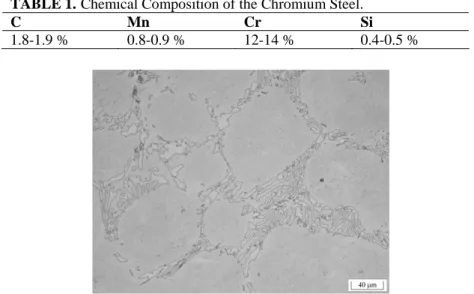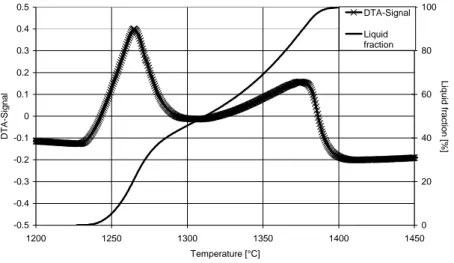Determination of the Influence of Alloying
Elements on Solidification Parameters Used for
the Study of the Thixoformability of a
Chromium Steel
C. Fraipont
1and J. Lecomte-Beckers
2MMS (IMGC, Bât. B52), University of Liège, Sart Tilman, 4000 Liège, Belgium
1
Celine.Fraipont@ulg.ac.be; 2Jacqueline.Lecomte@ulg.ac.be
Abstract. This paper deals with the examination of the influence of alloying elements on the thixoformability of a chromium steel. It focuses on the liquid fraction curves of different chromium steel with and without modification of composition. The liquid fraction versus temperature has been obtained experimentally by differential thermal analysis (DTA), limited to low heating rates. The correlation between liquid fraction and temperature has been studied. The effect of modifications of composition was observed.
Keywords: Thixoforming, DSC, DTA, chromium steel, alloying element, heating rate PACS: 81.30.Fb
INTRODUCTION
Thixoforming is the shaping of metal components in the semi-solid state. A major challenge is to develop alloys that can be successfully thixoformed. For this to be possible, the alloy must present a melting range broad enough and, for the forming, the microstructure has to consist of solid metal spheroids in a liquid matrix. It is thus important to characterize the microstructure and the solidus-liquidus interval of alloys to know their thixoformability. The curve of liquid fraction versus temperature can also give good information about the thixoformability of the alloys, using some characteristic parameters [1].
The alloys, to be thixoformable, necessitate a large solidification interval. So pure materials or eutectic alloys cannot be thixoformed. Moreover, the wider the solidification interval, the wider the processing window for thixoforming. The shape of liquid fraction versus temperature is also essential in the thixoformability of alloys. The liquid fraction sensitivity is defined as the rate of change of the liquid fraction with temperature and can be obtained by Differential Thermal Analysis (DTA) or by Differential Scanning Calorimetry (DSC). Here, DTA was used to ensure an accurate measure despite the heterogeneity of the sample. When the liquid fraction sensitivity is lower, it becomes easier to have an accurate liquid fraction by determination of the temperature in reheating experiments.
Kazakov [1] has summarized the critical parameters of the liquid fraction versus temperature curve:
• The temperature at which the slurry contains 50% liquid, T50%
• The slope of the curve at liquid fraction 50%,
[
dF dT]
T50%: to ensure an accurate liquid fraction, the liquid fraction sensitivity should be minimal, and so the curve has to be the flattest as possible• The temperature of the start of melting, TS: this temperature must be as low
as possible, which is one of the greatest difficulty with steel and however a very important parameter
• The difference (T50%-TS) : it determines the kinetics of dendrite
spheroidization during reheating, it must be as large as possible
In this article, a chromium steel with some variations in the composition of manganese and silicon is studied. The influence of Silicon and Manganese on the DTA curves and on the parameters determined by Kazakov, as mentioned above, will be analyzed.
MATERIALS
Basis material: chromium steel
The material used is a high carbon chromium steel of chemical composition described in Table 1. Carbides of M7C3 type can be seen on Figure 1. The
microstructure is composed of big dendritic grains with these eutectic carbides located at grain boundaries.
TABLE 1.Chemical Composition of the Chromium Steel.
C Mn Cr Si
1.8-1.9 % 0.8-0.9 % 12-14 % 0.4-0.5 %
Modifications in the chemical composition
Some modifications in the composition have been made to try to get a better structure for thixoforming. By theoretical analysis, two elements have been chosen, Silicon and Manganese. Silicon allows to increase the elastic modulus, the toughness and the oxidation resistance of the steel; however it can decrease the electric and thermal conductivity, that are necessary for an efficient inductive heating. When Silicon is present as dispersed inclusions, it makes the grains finer. But at high level, it precipitates as carbides, leading to coarse grains steel that are not desired for thixoforming. Thus no more than 3% silicon in composition can be used. Manganese gives also better mechanical properties to the steel and leads to finer grains. However, it may increase the shrinkage during solidification and decrease electric and thermal conductivity. This is a mandatory element in the composition of steel, because it combines with S to give MnS which is preferable to FeS: 0.5% of Manganese is the minimum to be used. It combines also with carbon in cementite leading to a complex (Fe,Mn)3C.
Six chemical compositions has been analysed (Table 2).
TABLE 2. Amount of Manganese and Silicon in the 6 Variations.
Mn Si Mn Si
Variation 1 1 0.5 Variation 4 1.5 0.5
Variation 2 1 1.5 Variation 5 1.5 1.5
Variation 3 1 3 Variation 6 1.5 3
DIFFERENTIAL THERMAL ANALYSIS
The liquid fraction versus temperature has been obtained experimentally by integration of Differential Thermal Analysis signal (DTA), with a heating rate of 15°C/min (Figure 2). These curves were used to outline the influence of Manganese and Silicon ratio on a chromium steel. It permits also to analyze the solidification range of the steel and its variations due to the different chemical compositions.
-0.5 -0.4 -0.3 -0.2 -0.1 0 0.1 0.2 0.3 0.4 0.5 1200 1250 1300 1350 1400 1450 Temperature [°C] D T A-Sig n a l 0 20 40 60 80 100 L iquid fracti o n [% ] DTA-Signal Liquid fraction
The DSC-Signal, on Figure 2, reveals two steps during the melting of the steel. The first peak corresponds to the dissolution of the carbide and the second one, smaller, to the fusion of the austenite. Thus, the liquid fraction presents an inflection after dissolution of the carbides. The peaks are similar for all the variations and only vary in position.
Influence of Manganese and Silicon on Chromium Steel
The Kazakov parameters were measured to study the influence of Manganese and Silicon. The results are resumed in Table 3.
TABLE 3. Kazakov parameters for the 7 alloys.
TS T50% TL T50%-TS TL-TS (dfL dT)T50% Basis alloy 1228 1306 1400 78 172 0.37 Variation 1 1229 1312 1406 83 177 0.38 Variation 2 1213 1278 1380 65 167 0.61 Variation 3 1224 1291 1395 67 171 0.47 Variation 4 1235 1297 1408 62 172 0.44 Variation 5 1235 1294 1401 59 166 0.43 Variation 6 1213 1267 1370 54 157 1.11
It is clear that the variation 1 presents the best combination of parameters: the lowest liquid fraction sensitivity at 50% of liquid fraction,( )
% 50
T L dT
df , the same as basis
alloy, and the largest interval between solidus temperature and temperature at 50% liquid, T50%-TS. The solidus temperature TS, is approximately the same as in the basis
alloy. It can be decreased by addition of Silicon as shown in variation 2; however, this leads to worse Kazakov parameters. In general, the variations (4, 5 and 6) with 1.5% of Manganese present bad parameters.
The particular influence of Silicon or of Manganese is difficult to determine because it seems that these two elements have a mutual influence.
0 20 40 60 80 100 1200 1250 1300 1350 1400 1450 Temperature [°C] Liqu id Fr act io n [% ]
Basis material Variation 1
Variation 2 Variation 3
Variation 4 Variation 5
Variation 6
It can be noticed on the liquid fraction versus temperature curves (Figure 3) that the different compositions do not give large differences. However, the curve associated to variation 1 leads to better parameters with a lighter slope at beginning, which is useful in thixoforming process where the liquid fraction used is small.
CONCLUSION
In conclusion, alloying elements can change the solidification parameters of steel. In the case studied in this article, for a high carbon chromium steel, it was shown that the best chemical composition, in regards with Kazakov parameters, is 1% Manganese and 0.5% Silicon. This alloy gives better properties than basis material. However, the influences remain weak. More investigations are thus needed to find appropriate elements to increase the thixoformability of this steel, while taking into account thermal parameters, but also the microstructure.
REFERENCES
1. A.A. Kazakov, “Alloy Compositions for Semisolid Forming” in Advanced Material and Processes -2000, pp. 31-34.


